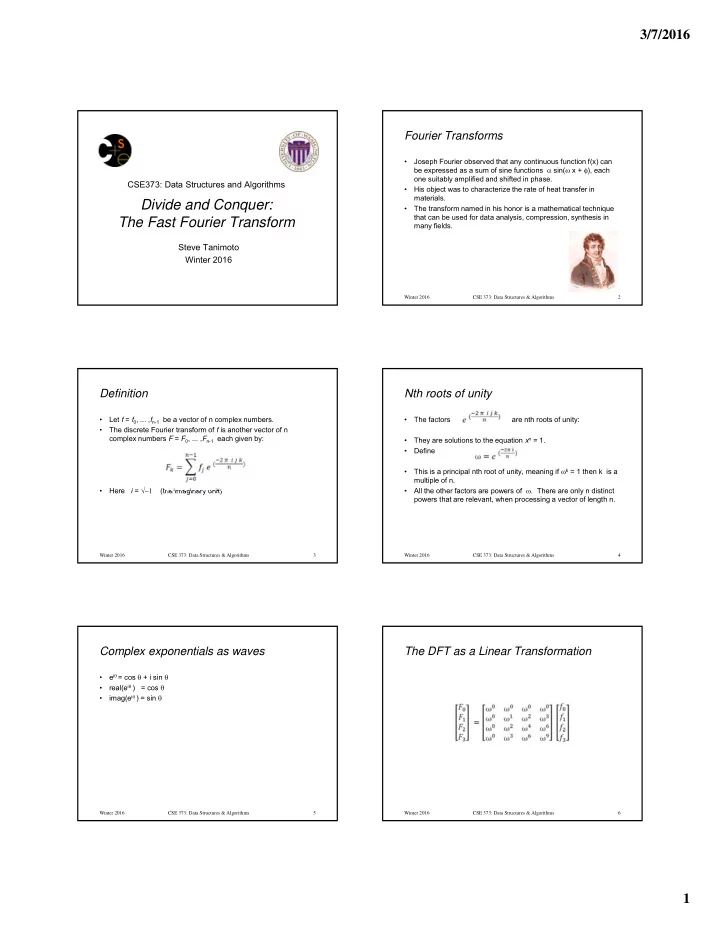

3/7/2016 Fourier Transforms • Joseph Fourier observed that any continuous function f(x) can be expressed as a sum of sine functions sin( x + ), each one suitably amplified and shifted in phase. CSE373: Data Structures and Algorithms • His object was to characterize the rate of heat transfer in materials. Divide and Conquer: • The transform named in his honor is a mathematical technique that can be used for data analysis, compression, synthesis in The Fast Fourier Transform many fields. Steve Tanimoto Winter 2016 Winter 2016 CSE 373: Data Structures & Algorithms 2 Definition Nth roots of unity • Let f = f 0 , ... , f n-1 be a vector of n complex numbers. • The factors are nth roots of unity: • The discrete Fourier transform of f is another vector of n They are solutions to the equation x n = 1. complex numbers F = F 0 , ... , F n-1 each given by: • • Define This is a principal nth root of unity, meaning if k = 1 then k is a • multiple of n. All the other factors are powers of . There are only n distinct • Here i = (the imaginary unit) • powers that are relevant, when processing a vector of length n. Winter 2016 CSE 373: Data Structures & Algorithms 3 Winter 2016 CSE 373: Data Structures & Algorithms 4 Complex exponentials as waves The DFT as a Linear Transformation e i = cos + i sin • real(e i ) = cos • imag(e i ) = sin • Winter 2016 CSE 373: Data Structures & Algorithms 5 Winter 2016 CSE 373: Data Structures & Algorithms 6 1
3/7/2016 Computing the Discrete Fourier Transform Divide and Conquer • Divide the problem into smaller subproblems, solve them, and combine into the overall solution • Solve subproblems recursively or with a direct method • Combine the results of subproblems • Apply dynamic programming, if possible Direct method: Assume the complex exponentials are precomputed. n 2 complex multiplications n(n-1) complex additions Winter 2016 CSE 373: Data Structures & Algorithms 7 Winter 2016 CSE 373: Data Structures & Algorithms 8 A Recursive Fast Fourier Transform An N log N algorithm def FFT(f): Like in merge sort, in each recursive call, we divide the number of n = len(f) elements in half. if n==1: return [f[0]] # basis case F = n*[0] # Initialize results to 0. The number of levels of recursive calls is therefore log 2 N. f_even = f[0::2] # Divide – even subproblem. When we combine subproblem results, we spend linear time. f_odd = f[1::2] # “ - odd subproblem F_even = FFT(f_even) # recursive call Total time is bounded by c N log N. F_odd = FFT(f_odd) # “ n2 = int(n/2) # Prepare to combine results for i in range(n2): twiddle = exp(-2*pi*1j*i/n) # These could be precomputed oddTerm = F_odd[i] * twiddle # Odd terms need an adjustment F[i] = F_even[i] + oddTerm # Compute a new term F[i+n2] = F_even[i] – oddTerm # Compute one more new term return F Winter 2016 CSE 373: Data Structures & Algorithms 9 Winter 2016 CSE 373: Data Structures & Algorithms 10 Recursive FFT FFT(n, [a 0 , a 1 , …, a n-1 ]): Unrolling the FFT if n=1: return a 0 F even = FFT(n/2, [a 0 , a 2 , …, a n-2 ]) F odd = FFT(n/2, [a 1 , a 3 , …, a n-1 ]) for k = 0 to n/2 – 1: (more detailed views ω k = e 2 π ik/n = F even k + ω k F odd k y k of how an FFT works) y k+n/2 = F even k – ω k F odd k return [y 0 , y 1 , …, y n-1 ] 2
3/7/2016 The Butterfly Step Recursion Unrolled A data ‐ flow diagram connecting the inputs x (left) to the outputs y that depend on them (right) for a "butterfly" step of a radix ‐ 2 Cooley– Tukey FFT. This diagram resembles a butterfly. http://en.wikipedia.org/wiki/Butterfly_diagram Comments FFTs in Practice • The FFT can be implemented: There are many varieties of fast Fourier transforms. They typically depend on the fact that N is a composite number, such as a • Iteratively, rather than recursively. power of 2. • In-place, (after putting the input in bit-reversed order) The radix need not be 2, and mixed radices can be used. • This diagram shows a radix-2, Cooley-Tukey, “decimation in Formulations may be recursive or iterative, serial or parallel, etc. time” FFT. There are also analog computers for Fourier transforms, such as • Using a radix-4 implementation, the number of scalar multiplies those based on optical lens properties. and adds can be reduced by about 10 to 20 percent. The Cooley-Tukey Fast Fourier Transform is often considered to be the most important numerical algorithm ever invented. This is the method typically referred to by the term “FFT.” The FFT can also be used for fast convolution, fast polynomial multiplication, and fast multiplication of large integers. Winter 2016 CSE 373: Data Structures & Algorithms 16 3
Recommend
More recommend